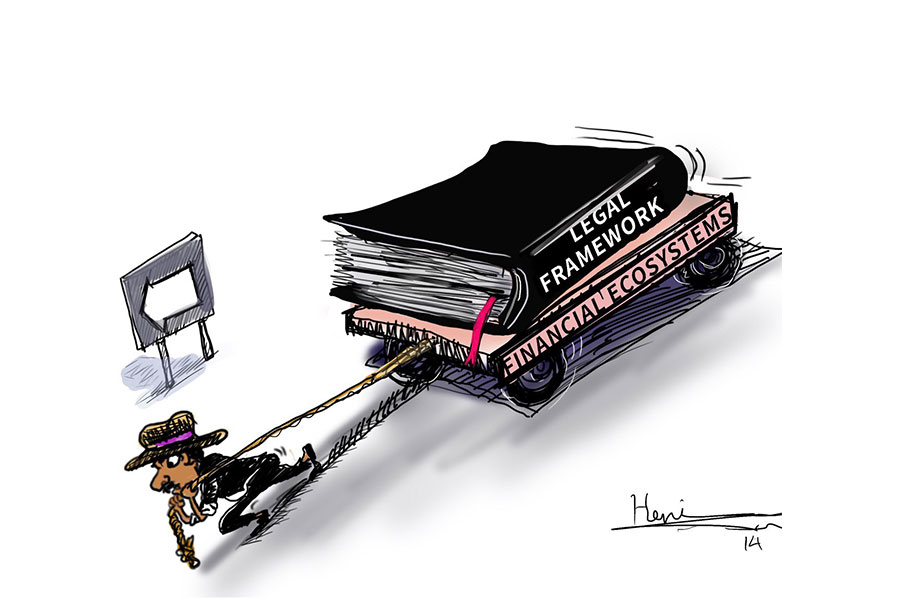
Letter To Editor | Aug 19,2024
Trade between China and Africa reached an all-time high of 282 billion dollars this year, as the modern China-Africa relationship nears 70 years old. The figure reflects a rise of 11pc from the previous year, which was also a record back then.
Imports from the most populous nation accounted for nearly 60pc of the trade volume, which amounts to 164 billion dollars, while exports earned 117 billion dollars. China has significant comparative advantages in most African countries with almost all products except primary commodities, such as oil seeds and coffee. Nigeria, South Africa and Egypt are the three most significant trading partners of China within the continent.
Ethiopia primarily exports oil seeds, flowers, coffee, and meat to China while it imports nearly everything from the world's second-biggest economy. In the past five months, 1.5 billion dollars had been earned from the export sector. Oil seeds account for 72 million dollars, while crops and khat earned 74.6 million and 116.5 million dollars, respectively, with coffee and gold accounting for the rest. Data from the National bank of Ethiopia reveals exports to Europe, which account for 38pc, is the major market for Ethiopian commodities.
Sisay Amare, president of the Ethiopian Pulses, Oilseeds & Spices Processors Exporters Association (EPOSPEO), would like to see exports to China increase.
He reasoned that export earnings are not where they should be compared to the total number of people involved in the sector. He accredited the underwhelming performance of the sector to logistics costs. The setting of price floors by the government also does not help in competing in international markets as someone could easily get an alternative seller somewhere in the world, he said.
Total merchandise import had reached five billion dollars at the end of 2022, with close to 61pc coming from Asia. Nearly half the volume of Asian imports makes its way straight from China.
The establishment of bilateral relationships between China and Africa began in the late 1950s, with only a few countries being free of colonial rule. The Bandung conference of 1955 in Indonesia set the theme of Afro-Asiatic relationships by laying out 10 principles, such as mutual benefit, non-aggression, non-interference in internal affairs, and peaceful coexistence, to define the following decades.
Until a gear shift towards a more market-oriented relationship was ushered following Mao's era in 1976, Oxford estimates total financial commitments of 2.4 billion dollars, mostly in interest-free loans. The notable project in this period was the construction of a 1,860Km railway from Tanzania to Zambia's copper fields which has seen declining traffic and maintenance issues over the years.
The current account deficit of Ethiopia reached 1.1 billion dollars in the final quarter of 2022, suggesting that while trade with China is increasing continentally, one of the two might be getting the short end of the stick.
China has never revealed bilateral aid numbers preferring to treat them like state secrets, which creates a fog that makes it difficult to assess the extent of its influence over the continent properly.
As the Chinese new year dawns, the role of Chinese development assistance to Africa was discussed in a public seminar at the Inter-Luxury Hotel the past week. The event, organized by Forum for Social Studies (FSS) and Chr. Michelsen Institute (CMI) presented case studies from different African countries.
Presented by Stein Sundstol Eriksen, a research professor, one study looked at how the relationship between China and Tanzania has evolved over the past 70 years. President John Magufuli, who took the reigns of power in Tanzania in 2015, referred to the 10 billion dollars loan for port construction agreed upon by the previous administration as "terms and conditions only a drunkard would accept".
The President then proceeded to rescind the project and then followed it up with an attempt to nationalise most of Tanzania's resources up until he died in 2021. Until Magufuli brought a decline in concessional loans from China, large-scale projects, such as a four billion dollars pipeline from Uganda to Tanzania under construction, were considered notable.
Aslak Orre and Muhidin Shangwe, lecturer in the Department of Political Science & Public Administration at the University of Dar es Salaam, also presented the cautionary tale of Mozambique, which is faced with a severe debt crisis. Mozambique averaged seven percent real GDP growth in the early 2000s and regularly registers more than double the debt to GDP ratio, which reached 122pc in 2020. The country borrowed heavily from external donors, particularly China, following a resource boom in 2006 to finance large-scale infrastructure projects.
While it had no debt to China before the resource boom, it now owes over two billion dollars, which is 20pc of its total external debt. The researcher, which had previously published a report referencing the hidden debt of Mozambique, estimates the actual cost of the borrowing at around 11 billion dollars in reduced economic activity and dragged two million people under the official poverty line.
Most of the borrowing financed large-scale infrastructure projects like bridges and roads. The Maputo bridge is an example of a Chinese-financed edifice, called "the bridge to nowhere", owing to its 680 million dollar construction cost and little to no use. Another grandiose project in Mozambique was the Maputo ring road project stretching 74Km which cost about 300 million dollars.
The similarity of these projects to Ethiopian infrastructure projects currently undergoing is unmistakable. The Addis Abeba -Djibouti railway at four billion dollars, the 'Beautifying Sheger' initiative at 250 million dollars, and a 1.8 billion dollar electric transmission lines to industrial parks are but a few of Chinese funded infrastructure investments.
Gedion Jaleta, CEO of the Center of Excellence International Consult, embellished China's economic engagement in Africa as 'aid mixed with investment'. He heralded China's non-interference in politics as market and trade orientation while indicating that bilateral trade between Ethiopia and China has reached six billion dollars.
Gedion ascribed the responsibility in the management of loans to be falling in the hands of host governments, and loans are not bad by themselves.
PUBLISHED ON
Jan 28,2023 [ VOL
23 , NO
1187]

Letter To Editor | Aug 19,2024

Covid-19 | May 09,2020

Fortune News | Dec 19,2021

Editorial | Aug 27,2022

Life Matters | Sep 19,2020

Fortune News | Dec 04,2022

Radar | Sep 08,2019

Commentaries | Apr 10,2023

Commentaries | Aug 21,2021

Verbatim | Aug 03,2019

Dec 22 , 2024 . By TIZITA SHEWAFERAW
Charged with transforming colossal state-owned enterprises into modern and competitiv...

Aug 18 , 2024 . By AKSAH ITALO
Although predictable Yonas Zerihun's job in the ride-hailing service is not immune to...

Jul 28 , 2024 . By TIZITA SHEWAFERAW
Unhabitual, perhaps too many, Samuel Gebreyohannes, 38, used to occasionally enjoy a couple of beers at breakfast. However, he recently swit...

Jul 13 , 2024 . By AKSAH ITALO
Investors who rely on tractors, trucks, and field vehicles for commuting, transporting commodities, and f...

Oct 25 , 2025
The regulatory machinery is on overdrive. In only two years, no fewer than 35 new pro...

Oct 18 , 2025
The political establishment, notably the ruling party and its top brass, has become p...

Oct 11 , 2025
Ladislas Farago, a roving Associated Press (AP) correspondent, arrived in Ethiopia in...

Oct 4 , 2025
Eyob Tekalegn (PhD) had been in the Governor's chair for only weeks when, on Septembe...